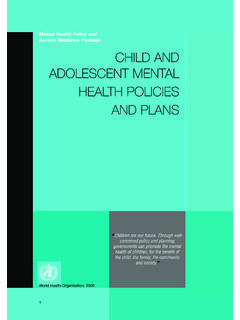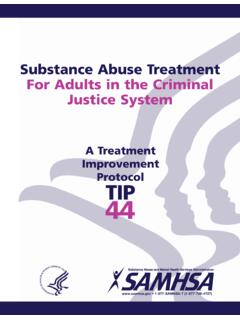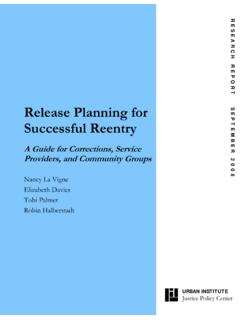Transcription of Guidelines on Representative Drug Sampling
1 Vienna International Centre, PO Box 500, 1400 Vienna, Austria Tel.: (+43-1) 26060-0, Fax: (+43-1) 26060-5866, Guidelines on Representative Drug Sampling FOR UNITED NATIONS USE ONLY. United Nations publication ISBN 978-92-1-148241-6. Sales No. Printed in Austria *0980042*. ST/NAR/38 April 2009 330 For use by National Drug Analysis Laboratories Photo credits: UNODC Photo Library Laboratory and Scientific Section United Nations Office on Drugs and Crime Vienna Guidelines on Representative Drug Sampling In cooperation with the Drugs Working Group of the European Network of forensic Science Institutes UNITED NATIONS. New York, 2009. ST/NAR/38. UNITED NATIONS PUBLICATION. Sales No. ISBN 978-92-1-148241-6. This publication has not been formally edited. Acknowledgements The present Guidelines on Representative drug Sampling were developed by the Drugs Working Group (WG) of the European Network of forensic Science Institutes (ENFSI).
2 They represent the result of an extensive consultation process among European drugs experts over the course of the years 2001-2003. The Laboratory and Scientific Section of the United Nations Office on Drugs and Crime is grateful about the agreement reached in 2007 with the ENFSI Drugs WG. to publish these Guidelines substantially unchanged* with the aim of making them available to a wider, international audience. The list of contributors to the original ENFSI publication is included on page iv. UNODC's Laboratory and Scientific Section also wishes to acknowledge the con- tributions of Dr. Reinoud Stoel, Netherlands forensic Institute, to the validation of the tables and software. * Changes have been made in chapter 1 (introduction) to adapt it for international use.
3 The ENFSI. foreword was replaced by the above acknowledgements. Tables and software were validated and relevant corrections made. An application for estimating tablet numbers was included in the software. The rest of the Guidelines remained substantially unchanged. iii List of contributors Sergio Schiavone (Chairman of the Sampling Subgroup of the ENFSI WG Drugs). Raggruppamento Carabinieri Investigazioni Scientifiche, Reparto di Roma, Sezione di Chimica Via Aurelia 511, 00165 Roma, Italia Phone 0039-06-66394656, Fax 0039-06-66394748, E-mail: Martine Perrin Institut de Recherche Criminelle de la Gendarmerie Nationale, department Toxicologie 1, Boulevard Theophile Sueur, F-93111, Rosny Sous Bois Cedex, France Phone 0033-1-49355079, Fax 0033-1-49355027, E-mail: Hugh Coyle (also macro development).
4 forensic Science Laboratory department of Justice, Equality and Law Reform, Garda Headquarters, Phoenix Park, Dublin 8, Ireland E-mail: Henk Huizer Netherlands forensic Institute Volmerlaan 17, 2288 GD Rijswijk, Netherlands (till Oct 15th, 2004). E-mail: Annabel Bolck Netherlands forensic Institute Volmerlaan 17, 2288 GD Rijswijk, Netherlands (till Oct 15th, 2004). E-mail: Bruno Cardinetti Raggruppamento Carabinieri Investigazioni Scientifiche, Reparto di Roma, Sezione di Balistica Via Aurelia 511, 00165 Roma, Italia Phone 0039-06-66394668, Fax 0039-06-66394748, E-mail: iv Contents Page 1. INTRODUCTION .. 1. 2. DEFINITIONS .. 3. 3. Representative Sampling TECHNIQUES .. 7. 4. ARBITRARY Sampling .. 9. 5. STATISTICAL Sampling METHODS .. 11. 6. CONSIDERATIONS AND RECOMMENDATIONS.
5 27. 7. ESTIMATION OF WEIGHT AND TABLET NUMBERS .. 33. References .. 37. Annexes I. Software instructions .. 39. II. Sampling on the national/regional/laboratory level .. 43. v Abbreviations ENFSI European Network of forensic Science Institutes EU European Union QA Quality Assurance TLC Thin-layer Chromatography PCWG Police Co-operation Working Group SWGDRUG Scientific Working Group on Drugs UNDCP United Nations Drug Control Programme (a predecessor of UNODC). UNODC United Nations Office on Drugs and Crime WG Working Group vi 1. Introduction The present Guidelines describe a number of Sampling methods, from arbitrary methods to methods with a statistical background. They focus on Sampling in cases where large numbers of relatively homogeneous material are available.
6 They do not deal with so-called tactical sam- pling, which may be applied for house-searches or in clandestine labora- tory investigations. These cases are characterized by different materials, sometimes in different amounts, different packages and/or sometimes with different suspects; these cases are considered as so specific and so dependent on the situation (also in legal aspects) that a guideline would be inadequate in many cases. Thus, the present Guidelines contain a number of Sampling strategies for cases with large numbers of items of relatively homogeneous material. However, from the descriptions of the Sampling methods, it is not automatically clear which strategy should be preferred (or would be optimum). This is mainly due to the fact that it is not possible to define a Sampling strategy, if the requirements have not been defined.
7 This is the main reason why it was decided to refrain from giving advice at local, regional or national level. In Guidelines for wider application, such as the present Guidelines , the advice cannot be as fine-tuned as it can be in a specific agreement between pros- ecutor, police, and chemist and laboratory management at local, national or regional level. However, some aspects of Sampling for international cases are discussed in chapter 6 and in annex II. Here, the advantages and disadvantages of various methods, also in relation with Sampling practice, are brought up. It seems that a Bayesian approach is a reasonable one in many cases, but its complexity might be a major drawback, especially for court. Fortunately, the hypergeometric and Bayesian approaches appear to show more or less the same results in cases where no prior probability is used.
8 Since Sampling is often carried out by police and customs, the guide- lines refrain from giving advice where the number of samples must be calculated for each separate case; this would be confusing and bother law enforcement personnel with computers or lists with Bayesian and hypergeometric tables. Therefore the final Sampling advice just mentions the (minimum) number of samples to be taken (5, 8 or 11, the number of samples being dependent on the circumstances). The forensic laboratory 1. 2 Guidelines on Representative Drug Sampling can then, if necessary, perform the final evaluation and probability calculations. The present Guidelines aim to support drug analysis laboratories in the selection of their Sampling strategy(ies) and best working practices. 2.
9 Definitions 1. Seizure The entire quantity of items seized. This may consist of a single population or a number of populations. 2. Population The collection of items under discussion. A population may be real or hypothetical; finite or infinite; homogeneous or heterogeneous. For the purposes of this booklet, the term population will refer to a real, finite homogeneous population unless otherwise specified. 3. Package A container for a single unit, a number of units or a number of other sub-packages. 4. Unit A single individual element of a population ( a single tablet or a single package containing powder). 5. Sample A unit or a number of units selected from a population. 6. Mean This is the average value of a set of measurements. The mean can refer to either: (a) The arithmetic mean of a population.
10 This is the true mean calculated from the entire population. It is denoted by . Or 3. 4 Guidelines on Representative Drug Sampling (b) The arithmetic mean of a sample. This is an estimate of . calculated from a sample of the population. It is denoted by X . Unless otherwise stated, the term mean will refer to the arithmetic mean of a sample as described in 6 (b). 7. Standard deviation This is a measure of the variation in the values of a set of measurements. The standard deviation can refer to either: (a) The standard deviation of a population. This is the true standard deviation calculated from the entire population. It is denoted by . Or (b) The standard deviation of a sample. This is an estimate of . calculated from a sample of the population. It is denoted by s.
















